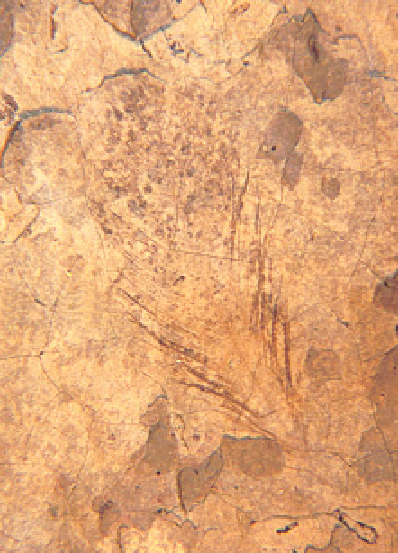Geoscience Reference
In-Depth Information
scavenging the bottom waters. The
pirate perch,
Aphredoderus sayanus
, is the
sole living representative of the family
Aphredoderidae; it is found only in
fresh waters of eastern and central
North America. Florissant has a single
extinct species,
Trichophanes foliarum
.
The living pirate perch is usually nocturnal
and feeds on invertebrates and small fish.
Oddly, given its freshwater nature,
Florissant has no fossils of any amphibians
(e.g. frogs) or reptiles (e.g. turtles). Birds
occur, however, but are rare. There is a
roller, a cuckoo, and a small plover. Isolated
feathers are also known (
247
). Mammals
are represented at Florissant only by
occasional single bones and teeth, mainly
from the lower mudstone unit. The only
mammal recorded from the lake shales is
an opossum. From the mudstones there is
evidence of the small, three-toed horse
Mesohippus
, a member of the extinct giant
brontotheres, and an oreodont. Since
Eocene times, horses have become larger
plains-dwellers; the brontotheres, which
included the largest land mammals ever,
and the oreodonts, pig-like creatures, have
both become extinct.
P
ALEOECOLOGY OF
F
LORISSANT
It should be clear that the majority of the
plants and animals found as fossils at
Florissant are rather similar to those alive
today, though not necessarily in the Rocky
Mountains. The main exceptions would be
the mammals. So what kind of habitat does
the fossil biota suggest? Many of the plants
belong to genera which are known from
numerous other Eocene sites around the
world to have been widespread at this time.
These include the redwoods (
Sequoia
),
maples (
Acer
), the tree of heaven
(
Ailanthus
), and the extinct
Cedrelospermum
.
Acer
is still widespread
but
Sequoia
and
Ailanthus
are now
restricted in their distributions (to coastal
California and south-east Asia and
northern Australia, respectively), which
indicates how difficult it can be to make
generalizations about, for example, climate
based on modern distributions of fossil
biota. No single place in the world today
has the range of flora seen at Florissant, but
the strongest affinities seem to lie with the
floras of present-day north-east Mexico and
southern Texas, south-east Asia, Pacific
North America, the southern Rockies, and
southern Appalachians. Possibly these
regions are all refugia: places where the
common inhabitants of once-widespread
forests have now retreated in the face of
new competition or some other factor.
Another method of determining
paleoclimate from fossils uses the shape
of leaves: physiognomy. This relies on
the fact that, in tropical forests nearly all of
the leaves have an
entire
margin, i.e. no
lobes or spikes, and they usually are waxy
and have a 'drip-tip'; these features help
rain water to run off quickly. Going
polewards into cooler climates, the leaves
become more toothed and lobed, so an
index was devised against which the
proportion of fossil leaves in any given
site can be compared (Wolfe, 1993). Using
247
247
Feather YPM. Length 42 mm 1.6 in.





Search WWH ::

Custom Search